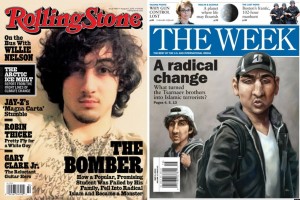The Terrorist Next Door

Sean Murphy, a Massachusetts state police sergeant, claimed that it
“glamorized the face of terror.” Eric Randall, blogging at BostonMagazine.com, suggested that a “cartoonish illustration”—such as the May 3, 2013 cover of The Week, which featured caricatures of Dzhokhar and Tamerlan Tsarnaev with darkened skin and large noses—would have been more appropriate. These illustrations evoke renderings of Osama bin Laden, creating a distance between the Tsarnaevs and other white Americans.
In their 2000 book The Black Image in the White Mind, communications scholars Robert Entman and Andrew Rojecki found that images of black suspects were four times more likely than images of white suspects to appear in local news reports. As historian Khalil Muhammad demonstrated in his 2010 book The Condemnation of Blackness, such depictions, combined with a lack of interaction between whites and blacks, contribute to white Americans’ tendency to see black men as criminals.
When the media attribute criminal behavior to racialized others, nonwhites are more likely to be be targeted for “stop-and-frisk” police tactics or such events as the shooting of Trayvon Martin by George Zimmerman and the shooting of Jordan Davis by Michael Dunn. These attributions also mask the crimes of whites, preventing us from seeing that the danger one poses to others is not determined by clothing or skin tone.
